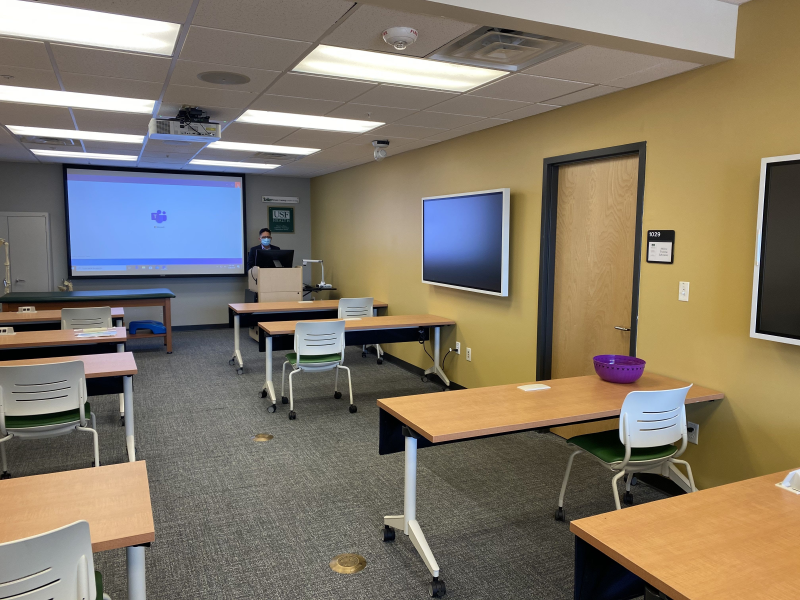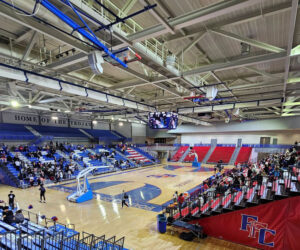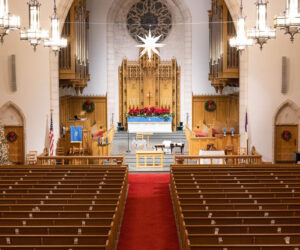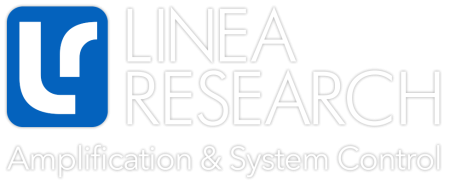The IT team at the University of South Florida (USF) in Tampa Bay tested and subsequently acquired a Sennheiser TeamConnect Ceiling 2 (TCC2) ceiling microphone array system in one of its main conference rooms, moving a step closer to realizing its goal of having a microphone in every classroom.
Once the pandemic hit in March of 2020, the USF IT team — and by extension the entire university — was faced with a pressing need to make its vision of implementing a campus-wide, hybrid learning scenario a reality. The previously installed TCC2 system paved the way for the university to greenlight a campus-wide installation of them across 96 classrooms.
“The very first thing we did was get our entire team together so we could do a full inventory assessment of the campus,” explains Michael Kraus, Audio Vision Engineering & Systems, USF IT. “We deployed emergency personnel on campus with PPE to document everything we had, and anything we didn’t have full information on. Did a particular room have a PC and an instructor source? Or just a wall plate? Did it have HDMI, was it analog?”

By April, the USF IT team had a full assessment of classroom readiness as well as a complete dashboard of what a hybrid solution might look like. This gave the university’s leadership the information it needed to make a decision. “We wanted a technology solution that enabled full student participation for both online and in-person,” says Kraus. “Noah [Kessler, Technology & Systems Manager, USF] came up with a design for about 700 rooms of what could be done, how much it would cost, and what it would look like to achieve this new definition of ‘flexible hybrid technology’.”
Kessler adds, “We always wanted to be able to mic an entire classroom, but until then didn’t see a solid cost-effective solution. When I saw the Sennheiser TCC2, we were eager to test it with a couple of rooms and experiment. Andrew [Kornstein, Customer Development & Applications Engineering, Sennheiser] brought it by and we installed it in one of our conference rooms. During the testing, we walked around the room to evaluate the quality of the microphone before jumping head first into this project. We knew we had a cost-effective solution.”
Once the scope of work and design phases were completed, the physical deployment took just three weeks. Working with the support from Sennheiser, USF’s IT and AV teams engaged integration firm AVI-SPL to assist with the installation. Jake Gilray of AVI-SPL recalls: “Mike [Kraus] called and said, ‘We’ve got a pretty big project and we will need a super-fast turnaround.’ The project entailed outfitting 96 classrooms across 17 buildings, and we had to have everything completed before classes started in the fall semester.”

The commissioned design called for both in-person and online students to engage within the classroom, using a camera and the TCC2. Gilray rallied his team at AVI-SPL to accommodate the compressed time frame. “USF staff are team players,” he says. “They take a collaborative approach to each project and communicate regularly with their partners. After we received the brief from USF, we understood what they wanted, and knew we could handle their requirements on deadline.”
USF’s IT team appreciate TCC2’s ability to handle different audio sources, making it an effective approach that can “play nicely” in almost any audio infrastructure. “For the most part, most of the signal routing was pretty straightforward,” says Kessler. “Typically we would take the analog out, connect this to our Crestron processor and then back out of it. If it came to needing more mics, we could integrate other Crestron USB mixers, or alternatively send signals straight into the computer using a Dante USB adapter. That’s the beauty of this system, because some competing units only offer Dante connectivity, or in some cases just an analog out. These limitations would have made the project a lot more difficult.” In addition to the TCC2 which handled all the audio signals, each room was outfitted with an audience cam and a professor cam.
Once all the TCC2 units were installed and tested, they performed as expected. “Sennheiser means quality when it comes to a microphone in my opinion,” Kessler says. “What really impressed me though is how well the product worked out of the box. Hang and bang, tweak a couple settings and then you are off to the next room. As far as performance, the audio is very clear and I really like the fact that you can create exclusion zones in two dimensions in case you have noise from an HVAC system or something — this is very exciting.”
USF expresses confidence that its TCC2 installation will continue imparting value to staff and students, not just during the pandemic, but well afterwards: “That was part of the original discussion,” Kraus concludes, “whether we could use all this equipment post-COVID. We know we will be able to use all these systems and it is a good future investment.” As a point of added value, many professors are using TCC2 to capture high quality recordings of their lectures, says Dominic Cesario, Lead Audiovisual Project Manager, USF. “Since the pandemic started, we have been encouraging instructors to use the recording capability within our videoconferencing software, and the mics in TCC2 allow for high quality audio capture.”





















